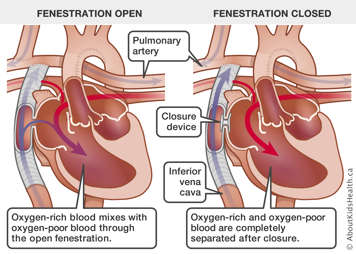What is fenestration closure after a Fontan operation?
Part of the Fontan operation involves making a tunnel to bring oxygen-poor blood directly from the body into the lungs. The tunnel connects the inferior vena cava to the pulmonary artery, bypassing the heart. It can be made in one of two ways:
- outside the heart (extracardiac conduit)
- inside the heart (lateral tunnel)
This new circulation can put extra pressure on the lungs while your child's body is getting used to it. To relieve this pressure, the surgeon makes a fenestration (hole) between the tunnel and the heart.
The fenestration allows some blood to flow from the tunnel into the heart. It acts as a temporary pressure release valve while your child's body is adjusting to the new circulation. It is usually closed several months after the Fontan operation, so that oxygen-poor and oxygen-rich blood no longer mix.
This information explains what happens when we close the hole. This procedure is done in the heart catheterization lab.

What is heart catheterization?
During heart catheterization, the doctor carefully puts a long, thin tube called a catheter into a vein or artery in your child's neck or groin. The groin is the area at the top of the leg. Then, the catheter is threaded through the vein or artery to your child's heart.
The doctor who does the procedure is a cardiologist, which means a doctor who works on the heart and blood vessels. This may not be your child's regular cardiologist.
To learn about heart catheterization, please see Heart catheterization: Getting ready for the procedure.
There are small risks of complications from the procedure
Generally, heart catheterization is a fairly low-risk procedure, but it is not risk-free. The doctor will explain the risks of heart catheterization to you in more detail before you give your consent for the procedure. The most common risks with fenestration closure are as follows:
The catheter may break through a blood vessel
There is a very small risk that the catheter may break through a blood vessel or the heart wall. To reduce this risk, we use a type of X-ray called fluoroscopy so we can see where the catheter is at all times.
Problems may occur with the closure device
While the device is being put in position, there is a risk that it may be put in the wrong place, move, or fall out of the fenestration. If this happens, the cardiologist will try to put it back in place. If this is not possible, surgery will be arranged to take out the device and close the fenestration.
For general information about the risks of heart catheterization, please see Heart catheterization: Getting ready for the procedure.
What does the closure device look like and how does it stay in place?
The closure device is made of metal and mesh material. It looks like a short tube with different-sized discs (circles) on either end. Before it is put in, the discs are folded so the device will fit in the catheter. When it is in the right place, one disc opens up as the device is moved out of the catheter. The tube portion plugs the hole and the other disc opens up on the opposite side of the hole.
What happens during the fenestration closure
The procedure is performed while your child is under a general anaesthetic. This means that your child will be asleep during the procedure.
During the procedure, the doctor inserts a catheter with a balloon on the tip into a blood vessel in the groin at the top of your child's leg. The catheter is moved up the blood vessel into the heart and into the fenestration. An X-ray picture is taken of the fenestration.
The balloon is then inflated so that it fills the hole and closes it for a short time. This lets the doctor see if your child's heart is ready to have the closure device in place. If the pressure is good, the closure device is threaded through the catheter and placed into the fenestration.
Once the device is in place, the doctor takes out the catheter and covers the cut on your child's leg with a bandage.
The procedure will take two to four hours
The procedure usually takes two to four hours. After the procedure, your child will go to the recovery room to wake up from the anaesthetic. If your child needs to stay overnight, they will be taken to the inpatient unit. If not, you can take your child home.
After the procedure
The cardiologist will let you know when your child can go home. Your child will stay in the hospital for at least four to six hours after the procedure. Most children can go home on the same day as the procedure.
If your child needs to stay overnight, they will be transferred to the inpatient unit.
For information on what to do after your child goes home, please see Heart catheterization: Caring for your child after the procedure.
Your child needs to take certain health precautions
Antibiotics to prevent infectious endocarditis
Your child has been taking antibiotics before and after dental treatments and surgery. These drugs help prevent a heart infection called infectious endocarditis. Your child will still need to take these drugs after the fenestration closure.
Coming back for a check-up
Your child will be given an appointment to see the cardiologist (heart specialist) six months to one year after the procedure. At that time, we will do tests to make sure that the hole is properly closed.
Write the date and time of the appointment here: